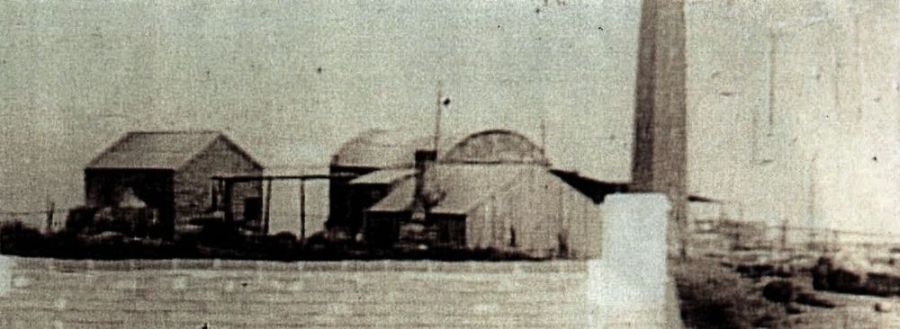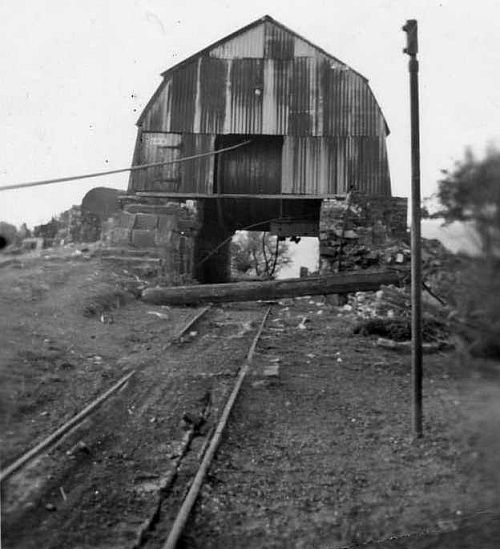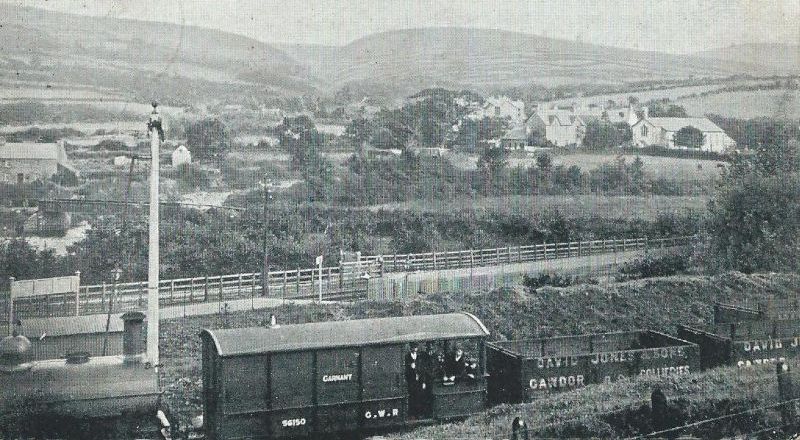Some Captured History of Glanamman
and Garnant
Cawdor Colliery (Garnant)

The Cawdor Colliery (New Cawdor), at Garnant was reputedly started
in 1894 by David Jones and Sons of Glanamman. The coal was extracted
via a drift mine which was situated a short distance North East of Pen-yr-heol
and North of Pen-y-waun, near the top of Brynceithin Road. (OS co-ordinates
269200 211600).
There was also a Cawdor Colliery (Old Cawdor), between Pant-y-ffynon
Farm and Ynys-y-frwynen Farm near Grenig Road in Glanamman. This was
working as early as 1880 when it was owned by Morgan and Thompson and
appears on OS maps until 1907 when it is no longer shown. Further coal
working in the area of the Old Cawdor by the Hopkin family of nearby
Pantyffynon Farm, however, continued into the later part of the 20th
Century.
There were two winding engines used at the new Cawdor Colliery; one
to wind the trucks up the slant and the second to lower coal down the
hill to the railway sidings, which were approximately half a mile from
the colliery. The "sidings" were where the coal was loaded
into the railway trucks.

Cawdor Colliery Winding House
David Jones and Sons had 'private siding agreements' (PSA's) with the
Great Western Railway (GWR), for the following dates:
Cwmtrupit Colliery:
1st October 1900,
14th Jul 1901,
New Cawdor: 13th September, 1904.
Looking at an Ordnance Survey map dated 1891, there is a coal pit in
the immediate vicinity of where the Cawdor Slant was later situated.
It is not certain what the name of this colliery was or who were the
owners. It may be tempting to assume that this was Cwmtrupit Colliery,
though this may not be the case as another map from 1901 shows an unnamed
coal pit a short distance to the south east near Llwyn-celyn, Garnant.
Another map dated 1907 shows both pits as "old shaft", with
the Cawdor Colliery engine house clearly marked a short distance to
the North. The tramway from the Cawdor Colliery to the railway sidings
is clearly marked on the 1907 map but is not marked on the 1901 or previous
maps. Given that the siding agreement dated 1904 named the associated
colliery as "New Cawdor", it may be the case that the tramway
was established at that time.

Coal Wagons marked "David Jones & Sons. Cawdor
Collieries", this image is from a postcard which was posted in
1903.
By 1908 the New Cawdor Colliery was owned by the Cawdor & Garnant
Colliery Ltd. of Garnant and these had a private siding agreement with
the Great Western Railway Company dated the 26th of August, 1908. Although
the new railway line had opened in November 1907, the sidings were still
operating from the old railway line. The manager of the Cawdor Colliery
at that time was Morgan Morgan and the under-manager was Phillip Rees.
There were 240 men employed at the Cawdor Colliery in 1908; 194 below
ground and 46 above. The Cawdor produced three grades of coal; large,
cobbles and culm.
The 8th of February, 1917 edition of the Amman Valley
Chronicle reported on the prosecution of a man charged with stealing
a piece of timber from the North Amman Colliery Company, who owned the
Cawdor Colliery. Police Constable David John Thomas saw the man carrying
the matchboard at 3.10am on the 15th of February 1917 and asked him
where he got it. The man told the police officer that he had taken it
from the Cawdor Colliery yard. When asked, he admitted that he had not
had permission as he was only taking it home for firewood.
During the man's trial, he told the court that on that morning he was
working "on the billy" and that it was very cold. He had seen
the wood lying on the yard with trams running over it and took it to
stir the fire up. Thomas Henry Beanland, who was an engineer at the
Cawdor Colliery, told the court that the man was employed at the Cawdor
Colliery but had no right to take the timber away. The value of the
timber was said to be 6d.
The magistrates ordered the man to pay costs and be bound over in £5
under the First Offenders Act for six months.
A private siding agreement dated the 8th of May 1916,
shows the owners of the Cawdor Colliery at that time were North Amman
Collieries Ltd, of Garnant. The same company were the registered owners
in 1918 and the number of men employed totalled 438. This number consisted
of 356 below ground and 82 above ground. The manager then was John Powell
of Garnant.
The 19th September 1918 edition of the A.V. Chronicle
reported on the legal proceedings brought against the Cawdor Colliery
agent and the colliery manager. The two officials were charged with
allowing the use of black powder in an area where gas had been found.
The black powder was more liable to flame than the permitted explosives
which is why it was prohibited.
The defence was that the same explosive was used in the other collieries
in the district and that up to the date of the offence (28th March 1918),
there was no report of gas being present in sufficient quantity to be
of any danger. The two officials were fined £5 each.
The fireman was also prosecuted for allowing men to work in a dangerous
place and for failing to fence the place. He was fined £1 for
each offence.
In 1923, the address for the North Amman Collieries Ltd.,
was 3 Dumfries Place, Cardiff. Their agent was named as Walter. S. Wardlaw.
Kelly's Directory for South Wales in 1923, listed him as Manager of
the North Amman Collieries Ltd, living at Glangarnant. The Cawdor Colliery
manager in 1923 was however, John Powell. The Cawdor employed 488 men
at that time; 407 below ground, working the Red Vein and 81 above ground.
The last owners of the Cawdor Colliery were Amalgamated
Anthracite Collieries Ltd., also known as the "Mond Combine",
after Sir Alfred Mond who owned the company. The Combine took control
of both the Cawdor and Cwmgorse Collieries Companies as from the 31st
of December 1924, at a cost of approximately half a million pounds.
That took the total number of collieries owned by the Mond Combine to
eight, these being: Tirydail, New Cross Hands, Llandybie, Gellyceidrim,
Crynant, Gurnos, Cawdor and Cwmgorse.
There was a private siding agreement with Amalgamated
Anthracite Collieries Ltd. dated the 27th of April 1925.
The 3rd and 10th of February 1927 editions of the Amman
Valley Chronicle, reported that the Cawdor Colliery was experiencing
a slack time through scarcity of trucks due to lack of orders and that
because of the trade depression, no more than four days per week had
been worked for several weeks.
July of 1927 saw a temporary closure of the colliery due
to a shortage of trucks. Up to the report appearing in the Amman Valley
Chronicle, the Cawdor Colliery had been closed for nine days, with the
men losing valuable pay during that period. The Gellyceidrim was also
affected by the shortage of trucks, but not as severely as the Cawdor.
On Monday the 12th of September, 1927, 462 workmen at
the Cawdor Colliery were given 14 days notice of termination of their
contract of employment. These consisted mainly of men who lived at Cwmamman,
but also included many from Gwaun-cae-gurwen.
By 1934, the Cawdor Colliery had it's own coal preparation
plant and 499 men were employed there, working the Red Vein seam. The
manager was John Powell.
The Private Siding Agreement between the Cawdor Colliery
and the Great Western Railway terminated on the 7th of April 1938.
In 1957, an airway was driven from the old Cawdor Colliery
to help in the ventilation of Cwmgorse Colliery; resulting in a tunnel
joining the two mines.
Local Alderman D. O. Morgan worked at the Cawdor as a
young man. In a local history video, he told how he remembered that
while other colliers had to work six full shifts a week, the workers
at the Cawdor were allowed to finish at around noon on a Saturday, providing
that the allocated amount of work had been completed.

Pen-y-waun Farm with the Cawdor buildings in the background
Much of the information on this page was taken from
the Amman Valley Chronicle and a series of newspaper cuttings from an
unknown source titled "Industrial Story of Garnant - by a Retired
Miner". The author of this piece is unknown. Thanks to Gomer Davies
(Archivist for the Amman Valley Railway Society), for the information
regarding the PSA's. Many thanks to W. Johnny Morgan and June Davies
for the images displayed on this page.
Close
Page
|